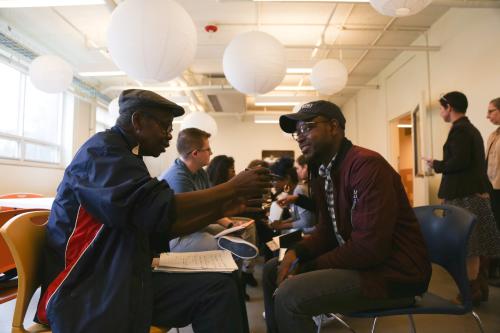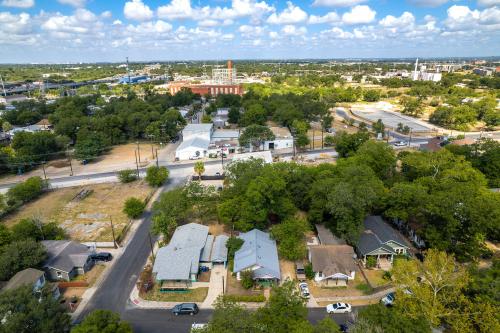Placemaking Postcards is a blog series from the Bass Center for Transformative Placemaking at Brookings where policymakers and practitioners guest-author promising placemaking efforts from across the U.S. and abroad that foster connected, vibrant, and inclusive communities. In line with the principle tenets of placemaking, the goal of the series is to recognize the community as the expert, highlight voices from the field, and to create a community of learning and practice around transformative placemaking.
In their landmark 2012 book “The Rainforest,” entrepreneurship experts Victor W. Hwang and Greg Horowitt explained the evolution of Silicon Valley by drawing a distinction between a planted field and a rainforest. A planted field produces exactly what is expected, while a rainforest creates unanticipated interactions among species which produce outcomes that could not have been foreseen. Silicon Valley is the result of a rainforest of unscripted interactions, not a planted field. That’s why visitors looking to see what produced the area’s miraculous entrepreneurship often find nothing except corporate headquarters—which are the result of that process, not its genesis.
Drawing on this analysis, the University of New Mexico (UNM) has cultivated a hybrid institution: Lobo Rainforest. It’s a six-story building specifically designed to anchor a seven-acre innovation site; it is, therefore, a planted field, in the sense that it is purpose-built and visible. Yet it also functions as a rainforest by hosting activities that enhance entrepreneurship through unpredictable interactions. Having recently celebrated its fifth anniversary, Lobo Rainforest now offers a model—as well as some vital insights—for other cities seeking to jump-start the unscripted interactions of an innovation rainforest.
A private-public partnership to ‘seed the rainforest’
In Silicon Valley and other innovative areas, serendipitous interactions typically take place in hubs like coffee shops—settings that are common across America and that often produce valuable social interactions, but do not necessarily catalyze entrepreneurship in a dramatic way. In Albuquerque, Lobo Rainforest was designed to actively spark those interactions on a number of levels.
The Lobo Rainforest building is a mixed-use facility with more than 100,000 square feet of space, creating a unique urban living and learning environment. It is the result of a partnership between InnovateABQ (the seven-acre innovation site), the city of Albuquerque, Bernalillo County, and UNM, among other partners.
InnovateABQ emerged from conversations that began in 2012 between the president of UNM, the mayor of Albuquerque, and the CEO of Nusenda Credit Union. They sought to strengthen the local economy through entrepreneurship and tighten ties between the university and downtown Albuquerque, which are about a mile apart along the famed Route 66.
With “The Rainforest” book as the guide, a commitment to explore the creation of an innovation site emerged. UNM hired the global design firm Perkins and Will to identify a location and create a master plan for it, which ultimately included Lobo Rainforest as the anchor. The city, county, and university raised the money needed to acquire the seven-acre site, with significant support from a federal grant from the Economic Development Administration. Over time, the initial group of civic leaders grew to become a broader and permanent advisory board.
The seven-acre site—the purpose of which is to spur entrepreneurial activity—is located midway between downtown Albuquerque and the UNM campus. Its centerpiece is Lobo Rainforest, which opened in 2017. The ground floor of Lobo Rainforest is home to UNM Rainforest Innovations (of which the author of this piece is CEO), the Cecchi VentureLab (UNM Rainforest Innovations’ incubator), the UNM Innovation Academy (a UNM student program to stimulate creativity, innovation, and entrepreneurship), Sandia National Laboratories’ tech engagement office, and the offices of global engineering firm General Atomics. Floors two through six provide housing and amenities for 310 UNM students.
Insights from Lobo Rainforest for building a successful innovation site
Several insights gained from developing Lobo Rainforest and the area that it anchors should be especially valuable to other cities.
First, an innovation site’s significance can far exceed its size and cost. Lobo Rainforest’s broader impact is both symbolic and catalytic. It is symbolic in that it draws attention to the stakeholder institutions’ commitment to promoting entrepreneurship; that vital message then spreads widely. It is catalytic in that it attracts entities to locate not only within the innovation site but also nearby.
In some cases, developers may prefer to be adjacent to the innovation site instead of within it. Among the incubators and related facilities that have emerged within easy walking distance of Lobo Rainforest are ABQid, FatPipe, Verge Fund, and the Central New Mexico Community College STEMulus Center’s IGNITE Community Accelerator and FUSE makerspace.
Together, the innovation site and nearby facilities create a distinctive presence in East Downtown. The site is identified by InnovateABQ signage, and Lobo Rainforest is also clearly branded. The Albuquerque Rail Trail, under construction, runs adjacent to the site and will enhance links to downtown by facilitating bicycling, running, and walking.
Second, even physical initiatives can develop organically rather than according to plan. While Lobo Rainforest and the innovation site are, in a sense, planted fields, their purpose is to spawn a rainforest of unexpected interactions. Those interactions can occur in the physical evolution of the site as well as in the conceptual evolution of ideas.
UNM Rainforest Innovations and InnovateABQ recently announced plans to develop a new facility adjacent to Lobo Rainforest called the Jungle, which will serve as a central gathering space where people with a variety of interests can work on new projects, form connections within the local entrepreneurial community, support local talent at the event space, and meet friends at the food hall or rooftop bar. The Jungle emerged from a connection between UNM Rainforest Innovations and Spatial Activations’ Vince Kadlubek, co-founder and former CEO of Meow Wolf, a unique arts and creative venue started in Santa Fe.
Finally, cultivators of innovation spaces need to stay closely engaged with the extended entrepreneurial community—not only entrepreneurs and aspiring ones but also investors, related businesses, and interested civic and political leaders. That community—both nearby and more broadly—plays a crucial part in spawning unexpected interactions and extending the impact of the innovation site’s support for entrepreneurship.
On numerous occasions, community members who share a commitment to entrepreneurship came forward with essential support. In some cases, that was vital political or symbolic support. In other cases, such as a $3 million grant from Nusenda Credit Union, it was financial as well.
Since 2013, about 60 startups have emerged through interactions with InnovateABQ. The reach of UNM Rainforest Innovations, however, extends far beyond Albuquerque. With a grant from the Economic Development Administration, UNM Rainforest Innovations is breaking down barriers and generating opportunities through entrepreneurship in historically underserved communities in New Mexico, with a primary focus on coal-impacted tribal communities. Through a partnership with Right to Start, a national nonprofit founded and led by “The Rainforest” co-author Victor Hwang that champions entrepreneurship as a civic priority, we are also identifying barriers to entrepreneurship across the state and exploring ways of removing them.
Harnessing the hybrid nature of Lobo Rainforest
The power of Lobo Rainforest’s hybrid model stems from the fact that it enables communities to plant a facility where rainforest-like interactions can take place. While not every community can create an innovation site of this size, its components offer a template of broad applicability.
A challenge for the model is that it is affected by the climate of real estate investment. At present, that includes the increased cost of borrowing money and weakened demand for commercial real estate. In response, we are working more closely with interested developers to help them understand—and ideally meet—the market for specific types of space such as wet labs.
Those issues aside, this is a long-term undertaking that has already yielded positive impacts through the current assemblage of assets, the collaborations stimulated, and the startups generated. In the process, the traditional choice between a planted field and a rainforest has been given an alternative. Lobo Rainforest offers a hybrid approach to spreading the seeds of an entrepreneurial rainforest widely.







Commentary
How a community innovation site is advancing entrepreneurship in Albuquerque
July 13, 2023